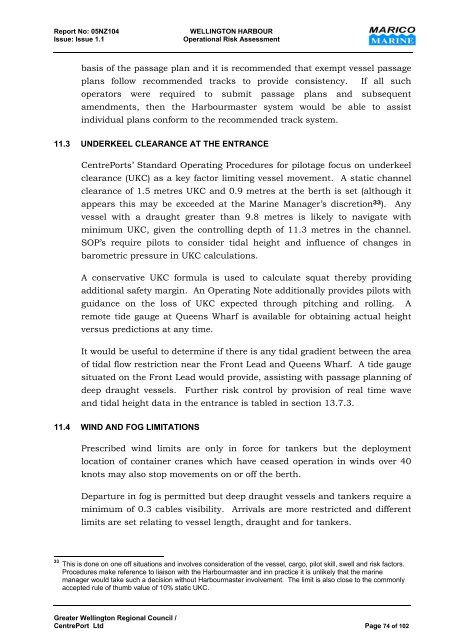MARICO Marine NZ Limited WELLINGTON HARBOUR PORT AND ...
MARICO Marine NZ Limited WELLINGTON HARBOUR PORT AND ...
MARICO Marine NZ Limited WELLINGTON HARBOUR PORT AND ...
You also want an ePaper? Increase the reach of your titles
YUMPU automatically turns print PDFs into web optimized ePapers that Google loves.
Report No: 05<strong>NZ</strong>104 <strong>WELLINGTON</strong> <strong>HARBOUR</strong><br />
Issue: Issue 1.1 Operational Risk Assessment<br />
basis of the passage plan and it is recommended that exempt vessel passage<br />
plans follow recommended tracks to provide consistency. If all such<br />
operators were required to submit passage plans and subsequent<br />
amendments, then the Harbourmaster system would be able to assist<br />
individual plans conform to the recommended track system.<br />
11.3 UNDERKEEL CLEARANCE AT THE ENTRANCE<br />
CentrePorts’ Standard Operating Procedures for pilotage focus on underkeel<br />
clearance (UKC) as a key factor limiting vessel movement. A static channel<br />
clearance of 1.5 metres UKC and 0.9 metres at the berth is set (although it<br />
appears this may be exceeded at the <strong>Marine</strong> Manager’s discretion33 ). Any<br />
vessel with a draught greater than 9.8 metres is likely to navigate with<br />
minimum UKC, given the controlling depth of 11.3 metres in the channel.<br />
SOP’s require pilots to consider tidal height and influence of changes in<br />
barometric pressure in UKC calculations.<br />
A conservative UKC formula is used to calculate squat thereby providing<br />
additional safety margin. An Operating Note additionally provides pilots with<br />
guidance on the loss of UKC expected through pitching and rolling. A<br />
remote tide gauge at Queens Wharf is available for obtaining actual height<br />
versus predictions at any time.<br />
It would be useful to determine if there is any tidal gradient between the area<br />
of tidal flow restriction near the Front Lead and Queens Wharf. A tide gauge<br />
situated on the Front Lead would provide, assisting with passage planning of<br />
deep draught vessels. Further risk control by provision of real time wave<br />
and tidal height data in the entrance is tabled in section 13.7.3.<br />
11.4 WIND <strong>AND</strong> FOG LIMITATIONS<br />
Prescribed wind limits are only in force for tankers but the deployment<br />
location of container cranes which have ceased operation in winds over 40<br />
knots may also stop movements on or off the berth.<br />
Departure in fog is permitted but deep draught vessels and tankers require a<br />
minimum of 0.3 cables visibility. Arrivals are more restricted and different<br />
limits are set relating to vessel length, draught and for tankers.<br />
33 This is done on one off situations and involves consideration of the vessel, cargo, pilot skill, swell and risk factors.<br />
Procedures make reference to liaison with the Harbourmaster and inn practice it is unlikely that the marine<br />
manager would take such a decision without Harbourmaster involvement. The limit is also close to the commonly<br />
accepted rule of thumb value of 10% static UKC.<br />
Greater Wellington Regional Council /<br />
CentrePort Ltd Page 74 of 102
















